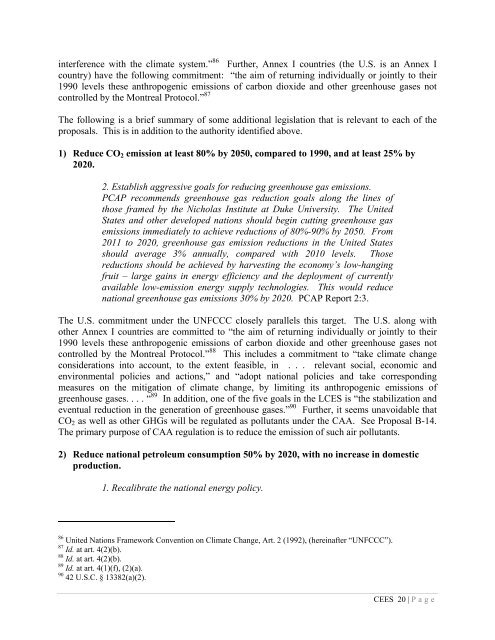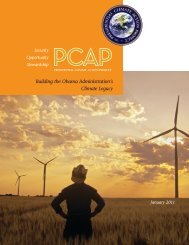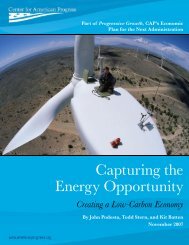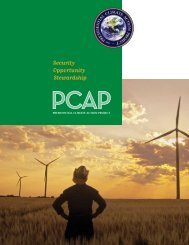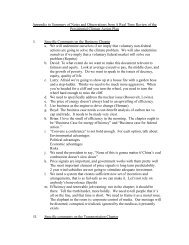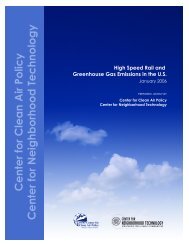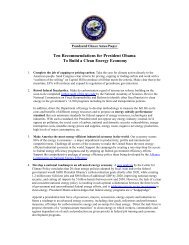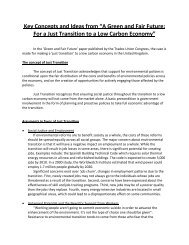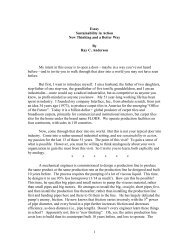the Nation, paying particular attention to the needs for full employment, price stability, energysecurity, economic growth, environmental protection, nuclear non-proliferation, special regionalneeds, and the efficient utilization of public and private resources. . . .” 77 In addition, the reportthat is submitted with the Plan shall include a summary of research and development effortsfunded by the Federal government to forestall energy shortages, to reduce waste, to fosterrecycling, to encourage conservation practices, and to otherwise protect environmental quality,including recommendations for developing technologies to accomplish such purposes . . .” 78The NEPP must include a least cost energy strategy (LCES). 79 The strategy must be designed to“achieve to the maximum extent practicable” five objectives. Three of these are specific targetsfor increasing energy efficiency, increasing energy derived from renewable resources, andreducing national oil consumption, although the target dates have passed for the first two, andone of the targets is “the stabilization and eventual reduction in the generation of greenhousegases.” 80 Further, there are seven priorities that “shall be given full consideration.” The prioritiesclosely parallel the targets proposed here. 81Given the President’s role and authority in planning national energy and climate change policy,resort to additional supporting legislation is not technically necessary to conclude that thePresident has the authority to take the action in this proposal. However, there is a substantialamount of legislation that supports air pollution prevention, 82 energy conservation, 83 energyefficiency, 84 and the increased use of renewable energy. 85 Many of these statutes were notpassed explicitly to address global warming; nonetheless, they are all strategies to reducegreenhouse gas emissions and are supported by the establishment of the goals and targetsproposed here. Thus, these laws lend an additional level of legitimacy and credibility to theproposed directive in that the directive furthers the purposes and goals of the statutes and thepolicies represented by these laws.Finally, it should not go without mention that the U.S. is a party to and has ratified the UNFCCC.See Chapter II, part D. Although the U.S. is not committed to specific GHG reductions targetsbecause the U.S. is not a party to the Kyoto Protocol, as a party to the UNFCCC the U.S. iscommitted to the following objective: “to achieve . . . stabilization of greenhouse gasconcentrations in the atmosphere at a level that would prevent dangerous anthropogenic77 42 U.S.C. § 7321(b)(1) (emphasis added).78 Id. at § 7421(c)(4).79 Id. at § 13382(a) (the LCES is prepared by the DOE).80 Id. (the specific targets are specific goals in the following areas: increase energy efficiency, energy derived fromrenewable resources, and a reduction in national oil consumption).81 Id. at § 13382(d).82 See, e.g., the following Chapters of Title 42: 133 Pollution Prevention, 85 Air Pollution Prevention and Control(see especially 42 U.S.C. §§ 7410-7627 (the CAA)), 56 Environmental Quality Improvement, and 55 NationalEnvironmental Policy.83 See e.g., the following chapters of Title 42: 152 Energy Independence and Security, 149 National Energy Policyand Programs, 134 Energy Policy, 91 National Energy Conservation Policy, 81 Energy Conservation and ResourceRenewal, and 77 Energy Conservation.84 Id.85 See, e.g., the following Chapters of Title 42: 152 Energy Independence and Security, 125 Renewable Energy andEnergy Efficiency Technology Competitiveness, 96 Biomass Energy and Alcohol Fuels, and 71 Solar Energy.CEES 19 | P age
interference with the climate system.” 86 Further, Annex I countries (the U.S. is an Annex Icountry) have the following commitment: “the aim of returning individually or jointly to their1990 levels these anthropogenic emissions of carbon dioxide and other greenhouse gases notcontrolled by the Montreal Protocol.” 87The following is a brief summary of some additional legislation that is relevant to each of theproposals. This is in addition to the authority identified above.1) Reduce CO 2 emission at least 80% by 2050, compared to 1990, and at least 25% by2020.2. Establish aggressive goals for reducing greenhouse gas emissions.<strong>PCAP</strong> recommends greenhouse gas reduction goals along the lines ofthose framed by the Nicholas Institute at Duke University. The UnitedStates and other developed nations should begin cutting greenhouse gasemissions immediately to achieve reductions of 80%-90% by 2050. From2011 to 2020, greenhouse gas emission reductions in the United Statesshould average 3% annually, compared with 2010 levels. Thosereductions should be achieved by harvesting the economy’s low-hangingfruit – large gains in energy efficiency and the deployment of currentlyavailable low-emission energy supply technologies. This would reducenational greenhouse gas emissions 30% by 2020. <strong>PCAP</strong> Report 2:3.The U.S. commitment under the UNFCCC closely parallels this target. The U.S. along withother Annex I countries are committed to “the aim of returning individually or jointly to their1990 levels these anthropogenic emissions of carbon dioxide and other greenhouse gases notcontrolled by the Montreal Protocol.” 88 This includes a commitment to “take climate changeconsiderations into account, to the extent feasible, in . . . relevant social, economic andenvironmental policies and actions,” and “adopt national policies and take correspondingmeasures on the mitigation of climate change, by limiting its anthropogenic emissions ofgreenhouse gases. . . . “ 89 In addition, one of the five goals in the LCES is “the stabilization andeventual reduction in the generation of greenhouse gases.” 90 Further, it seems unavoidable thatCO 2 as well as other GHGs will be regulated as pollutants under the CAA. See Proposal B-14.The primary purpose of CAA regulation is to reduce the emission of such air pollutants.2) Reduce national petroleum consumption 50% by 2020, with no increase in domesticproduction.1. Recalibrate the national energy policy.86 United Nations Framework Convention on <strong>Climate</strong> Change, Art. 2 (1992), (hereinafter “UNFCCC”).87 Id. at art. 4(2)(b).88 Id. at art. 4(2)(b).89 Id. at art. 4(1)(f), (2)(a).90 42 U.S.C. § 13382(a)(2).CEES 20 | P age
- Page 1 and 2: THE BOUNDARIES OF EXECUTIVE AUTHORI
- Page 4 and 5: This page left intentionally blank.
- Page 6 and 7: Proposal IndexPage NumberA Establis
- Page 8 and 9: D-01 Direct the federal Climate Cha
- Page 10: I. IntroductionThis report is a fol
- Page 16 and 17: • The President shall not substit
- Page 18 and 19: 42, Chapter 77, Subchapter III expl
- Page 20 and 21: In addition, it delegates to the Pr
- Page 22 and 23: C. Presidential ProclamationsThere
- Page 24 and 25: 2. The developed country Parties an
- Page 26 and 27: A. Establish National Energy and Ca
- Page 30 and 31: The President should establish the
- Page 32 and 33: The President should establish the
- Page 34 and 35: This proposal is framed in terms of
- Page 36 and 37: partnership is working to reduce me
- Page 38 and 39: Good candidate to implement by exec
- Page 40 and 41: Executive Orders. There are 30 exec
- Page 42 and 43: Congress annually a comprehensive r
- Page 44 and 45: The Rural Utilities Services (RUS)
- Page 46 and 47: through the energy policy, has some
- Page 48 and 49: Direct the EPA to work with the Chi
- Page 50 and 51: private members: E.O. 12216, the Pr
- Page 52 and 53: next 20 years.” 181 From the publ
- Page 54 and 55: Direct the EPA to immediately begin
- Page 56 and 57: scientific judgment.” 199 Further
- Page 58 and 59: Direct the EPA to immediately grant
- Page 60 and 61: of climate change in California are
- Page 62 and 63: Direct the EPA and DOE to collabora
- Page 64 and 65: The ATA is a private entity, and as
- Page 66 and 67: and Bioenergy, establishes an inter
- Page 68 and 69: Authority over the Entities Subject
- Page 70 and 71: Direct the DOT to reconvene the Cli
- Page 72 and 73: Direct NASA to restore earth scienc
- Page 74 and 75: Direct the Council on Environmental
- Page 76 and 77: C. Improve Federal StewardshipDirec
- Page 78 and 79:
3. Background.OMB performs legislat
- Page 80 and 81:
There are numerous executive orders
- Page 82 and 83:
Federal Energy Management Executive
- Page 84 and 85:
1973; (3) E.O. 12845, Requiring Age
- Page 86 and 87:
This proposal is consistent with an
- Page 88 and 89:
4. GHG reduction goals to transport
- Page 90 and 91:
President, but the President “may
- Page 92 and 93:
Declare that it is the responsibili
- Page 94 and 95:
1. Statutory provisions that establ
- Page 96 and 97:
whenever feasible; and disposal or
- Page 98 and 99:
species is listed as a threatened s
- Page 100 and 101:
Determination of priorities which a
- Page 102 and 103:
3.2 Declaring that it is the respon
- Page 104 and 105:
Management, (June 3, 1999) includes
- Page 106 and 107:
economic, and other requirements of
- Page 108 and 109:
environment.” Based on the polici
- Page 110 and 111:
D. Protect American Taxpayers from
- Page 112 and 113:
special committees but are expressl
- Page 114 and 115:
Direct the federal Climate Change S
- Page 116 and 117:
The CCSP is an executive branch age
- Page 118 and 119:
E. Mobilize the MarketplaceDirect t
- Page 120 and 121:
pollutants. Further, courts give gr
- Page 122 and 123:
Direct the Council on Environmental
- Page 124 and 125:
methods, and data related to sustai
- Page 126 and 127:
F. Build Public-Private Partnership
- Page 128 and 129:
printed in the Federal Register and
- Page 130 and 131:
that officer or employee. Advisory
- Page 132 and 133:
A-06A-07B-01B-02B-03B-04B-05B-06B-0
- Page 134 and 135:
C-02.7C-02.8C-02.9C-03C-03.1C-03.2C
- Page 136 and 137:
Appendix AStatutes with Specific Te
- Page 138 and 139:
(C) assess the potential for the de
- Page 140 and 141:
15 U.S.C.A. § 657hTitle 15. Commer
- Page 142 and 143:
(5) Climate fluctuation and change
- Page 144 and 145:
(4) global data collection, and mon
- Page 146 and 147:
15 U.S.C.A. § 2932§ 2932. Committ
- Page 148 and 149:
implementation of any Federal actio
- Page 150 and 151:
(2) Projects eligible for funding u
- Page 152 and 153:
emissions associated with each type
- Page 154 and 155:
22 U.S.C.A. § 7902§ 7902. Reducti
- Page 156 and 157:
(c) Performance reviews and reports
- Page 158 and 159:
(3) Priority for integrated gasific
- Page 160 and 161:
[It is the purpose of this chapter
- Page 162 and 163:
(i) that no low greenhouse gas emit
- Page 164 and 165:
(3) prepare and transmit to the Con
- Page 166 and 167:
42 U.S.C.A. § 13384§ 13384. Asses
- Page 168 and 169:
(i) Selection of projects(3) In sel
- Page 170 and 171:
(1) In generalThe Secretary, in con
- Page 172 and 173:
(b) GoalsThe program shall have the
- Page 174 and 175:
Subchapter II. Energy Security thro
- Page 176 and 177:
Subchapter IV. Energy Savings in Go
- Page 178 and 179:
(B) to reduce emissions of covered
- Page 180 and 181:
§ 17334. Actions by overseas priva
- Page 182 and 183:
(5) be committed to minimizing admi
- Page 184 and 185:
Appendix BProclamations that Addres
- Page 186 and 187:
8) Proc. 7150, Nov. 20, 1998, World


